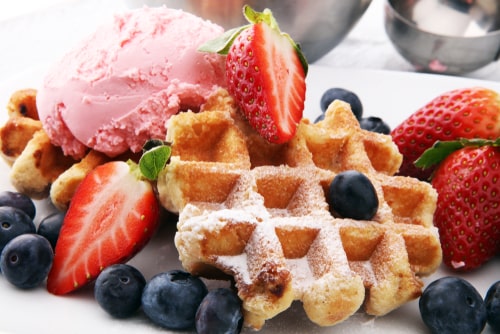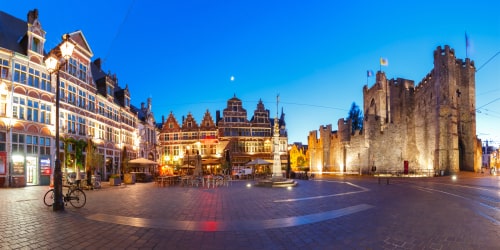Last updated on July 25th, 2022
48. Belgium is the 5th smallest country in the European Union. Slovenia, Cyprus, Luxembourg, and Malta are smaller than Belgium. France is the largest of all European Union countries. Austria, Bulgaria, Croatia, Czech Republic, Denmark, Estonia, Finland, Germany, Greece, Hungary, Ireland, Italy, Latvia, Lithuania, Netherlands, Poland, Portugal, Romania, Slovakia, Spain, Sweden, United Kingdom are the remaining countries that constitute the European Union.
49. Belgians love cycling and they make use of cycles for most short-distance trips.
50. Belgium is also famous for its peeing boy statue – the Manneken Pis (meaning “Little man Pee” in Dutch.) It is situated in Brussels.

51. The country, in 1921, also became the world’s first to have a female parliamentarian.
52. Voting is compulsory in Belgium.
53. Apart from Belgium, voting is compulsory and enforced in the following regions: Argentina, Australia, Brazil, Ecuador, Liechtenstein, Luxembourg, North Korea, Nauru, Peru, Singapore, Uruguay, Schaffhausen canton in Switzerland. In these regions voting is compulsory but it is not enforced: Bolivia – Introduced in 1952, Bulgaria – Introduced in 2016, Costa Rica, Democratic Republic of the Congo, Dominican Republic – Compulsory from the age of 18, Egypt, Gabon, Greece, Guatemala, Honduras, Lebanon – Men only, Libya, Mexico, Panama, Paraguay – Compulsory for citizens between 18 and 75 years old, non-compulsory for those older than 75, Thailand and Turkey.
54. Belgium is also among the top processors of cobalt, radium, copper, zinc, and lead in the world.
55. Nemo 33 (maximum depth is 34.5 metres; opened on May 1, 2004), an indoor non-chlorinated freshwater facility in Brussels, Belgium is the world’s second deepest swimming pool after the Y-40 Deep Joy (maximum depth is 40 metres; opened on 5 June 2014) swimming pool in Italy.
56. The country’s households also boast the highest percentage of cable TV in the world at 97%.
57. The headquarters of NATO, located in Brussels, Belgium hosts over 5,000 meetings every year. Initially, the headquarters was located in London, and then it was moved to Paris in 1952, before finally being transferred to Brussels, Belgium in 1967.
58. Belgium is world’s 81st most populous country (2022 est.)
59. Electronic identity cards were introduced in Belgium for the first time in the world.
60. Belgians love pets, which is why the majority of the families in Belgium have pets.
61. Fast food is not much liked by the Belgians. No doubt, they have the least number of fast food restaurants in Belgium as compared to other European countries.
62. The country is lit up more brightly than any other country, thanks to its highly dense highway network.
63. Belgium has a heavy road and railway density, and the transportation is well developed in the country.
64. Belgium also has one of the highest gasoline prices, too. Norway has the highest gasoline prices and Venezuela has the cheapest gasoline in the world. Learn more about gasoline prices and other related information here.
65. Did you know that Brussels has more than 1000 NGOs and over 120 international governmental organizations?
66. According to the data published by the CIA, in 2016, Belgium ranks at 20th spot among the top exporting countries in the world. China leads the chart, while the United States occupies the third spot.

66. Belgium is famous for – Waffles, fries, chocolate, and beer.
67. Interestingly, when a baby is born in Ghent, Belgium, the streetlights in the Sint-Veerleplein city square flicker on and off to mark the occasion.

68. Sugar beets, chicory, flax, cereal grains, and potatoes are the major crops of Belgium.
69. Coal was once Belgium’s one of the most important natural resource. By the 1960s, Belgium’s easily extractable coal reserves were exhausted. And by 1992, the coal mining industry came to a complete halt. Belgium now imports coal for use in the steel industry and domestic heating.
70. Nuclear reactors play a significant role in generating electricity for Belgium as they meet more than half of the country’s demand for electricity.

71. The Hallerbos – also known as the Blue forest — is a forest in Belgium, which covers an area of 1,360 acres. This mighty forest gets covered with bluebells between late April and May.
72. There is a tiny city of Doel in Belgium, which is scheduled to be destroyed. Wondering why? Because the city is adjacent to Antwerp and the port of Antwerp needs room to expand. Today, there are just 25 residents and plenty of art on the walls from various street artists from across Europe. Art on the walls of the city is an attempt to save it from further demolition.
73. The longest subterranean river known in the world–the Rubicon–is located in Belgium in the Caves of Remouchamps.
74. Belgium is also home to the only museum–Bibliotheca Wittockiana–in the world, which is dedicated to bookbinding and book arts. The museum houses more than 3,000 art bindings from the 16th to 21st centuries. However, an appointment is needed to view the collection.
Belgium – country at a glance
| Independence | 4 October 1830 (a provisional government declared independence from the Netherlands); 21 July 1831 (King LEOPOLD I ascended to the throne) |
|---|---|
| Capital City | Brussels (50°51′N 4°21′E) |
| Largest City | Brussels (50°51′N 4°21′E) |
| Area | total: 30,528 sq km land: 30,278 sq km water: 250 sq km (about the size of Maryland) |
| Land boundaries | total: 1,297 km border countries (4): France 556 km, Germany 133 km, Luxembourg 130 km, Netherlands 478 km |
| Population | 11,977,634 (2024 est.) |
| Official Language | Dutch French German |
| Borders | France, Germany, Luxembourg, Netherlands |
| Currency | Euro (€) (EUR) |
| Suffrage | 18 years of age; universal and compulsory |
| Demonym | Belgian |
| Religion | Roman Catholic |
| Life expectancy at birth | 82.3 years (2024 est.) Life expectancy at birth indicates the number of years a newborn infant would live if prevailing patterns of mortality at the time of its birth were to stay the same throughout its life. |
| Climate | temperate; mild winters, cool summers; rainy, humid, cloudy |
| Terrain | flat coastal plains in northwest, central rolling hills, rugged mountains of Ardennes Forest in southeast |
| Mean elevation | 181 m |
| Lowest point | North Sea 0 m |
| Highest point | Botrange 694 m |
| Coastline | 66.5 km |
| National anthem | "La Brabanconne" (The Song of Brabant) |
| Government type | federal parliamentary democracy under a constitutional monarchy |
| Monarch | Philippe |
| Prime Minister | Bart De Wever |
| National colors | red, black, yellow |
| National symbol | golden rampant lion |
| Natural resources | construction materials, silica sand, carbonates, arable land |
| Agricultural land | 44.1% |
| Birth rate | 10.8 births/1,000 population (2024 est.) |
| Death rate | 9.5 deaths/1,000 population (2024 est.) |
| Sex ratio | 0.97 male(s)/female (2024 est.) |
| Industries | engineering and metal products, motor vehicle assembly, transportation equipment, scientific instruments, processed food and beverages, chemicals, pharmaceuticals, base metals, textiles, glass, petroleum |
| Exports | $542.508 billion (2023 est.) cars and vehicle parts, refined petroleum, packaged medicines, medical cultures/vaccines, diamonds, natural gas (2019) |
| Imports | $546.426 billion (2023 est.) cars, refined petroleum, packaged medicines, medical cultures/vaccines, diamonds, natural gas (2019) |
| GDP - per capita (PPP) | $64,200 (2023 est.) |
| Time Zone | CET (UTC+1) |
| Internet country code | .be |
| Drives on the | Right |
| Calling Code | +32 |
| Table last updated | March 02, 2025 |
